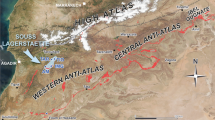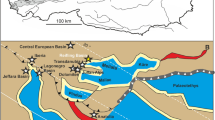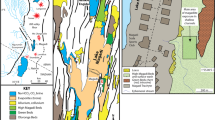Abstract
THE Dwyka Subgroup, forming the basal division of the Karroo Group, comprises a thick sequence of glacial morainic debris and boulder shales, together with subordinate shales, varvites, and lenticular sandstones. In the southern Cape, tillitic rocks are overlain by the so-called “Upper Dwyka shales”, an argillaceous sequence at the top of which are white-weathering carbonaceous shales, the “White Band”. The latter is overlain by a thin but persistent chert band which forms the arbitrary boundary with the overlying Ecca Subgroup. The Upper Dwyka shales have yielded all the animal fossils of this subgroup in the southern Cape. McLachlan and Anderson1 have recorded orthocerid nautiloids, the brachiopod Attenuatella, the bivalves Phestia and (?)Nuculopsis, palaeoniscoid fish, radiolarians, spiral coprolites suggestive of the presence of sharks, fossil wood, foraminifers, and miospores from the base of the succession near Kimberley. They2 favoured a Sakmarian age for this marine incursion. The non-marine2 White Band has yielded the aquatic reptile Mesosaurus and the crustaceans Notocaris, “Pygaspis”, and Anthrapalaemon.
This is a preview of subscription content, access via your institution
Access options
Subscribe to this journal
Receive 51 print issues and online access
$199.00 per year
only $3.90 per issue
Buy this article
- Purchase on Springer Link
- Instant access to full article PDF
Prices may be subject to local taxes which are calculated during checkout
Similar content being viewed by others
References
McLachlan, I. R., and Anderson, A., Palaeont. afr., 15, 37 (1973).
McLachlan, I. R., and Anderson, A., IUGS, Gondwana Symp., Abstr., 3, 42 (1973).
Martin, H., Trans. geol. Soc. S. Afr., 56, 37 (1953).
Martin, H., and Wilczewski, N., IUGS, Gondwana Symp., 2 225 (1970).
Martin, H., Walliser, O. H., and Wilczewski, N., IUGS, Gondwana Symp., 2, 621 (1970).
Martin, H., Trans. geol. Soc. S. Afr. Annex., 64, 1 (1961).
Germs, G. J. B., Bull. P.R.U., Univ. Cape Town, 12, 1 (1972).
Martin, H., The Precambrian Geology of South West Africa and Namaqualand (University of Cape Town, 1965).
Theron, J. N., The Stratigraphy and Sedimentation of the Bokkeveld Group (Thesis, Stellenbosch, 1972).
Brunton, C. H. C., Cocks, L. R. M., Rowell, A. J., and Rust, I. C., Q. Jl. geol. Soc. Lond., 125, 583 (1970).
Visser, H. N., Ann. Geol. Surv. S. Afr., 6, 31 (1967).
Stratten, T., Palaeont. afr., 11, 127 (1968).
Theron, J. N., and Blignault, H. J., IUGS, Gondwana Symp., 3 (in the press).
Ahmad, F., IUGS, Gondwana Symp., 2, 179 (1970).
Lindsay, J. F., IUGS, Gondwana Symp., 2, 477 (1970).
Hill, D., Trans. R. Soc. N.Z., Geol., 2, 137 (1964).
Palmer, A. R., and Gatehouse, C. G., Prof. Pap. U.S. geol. Surv., 456 D, 1 (1972).
Author information
Authors and Affiliations
Rights and permissions
About this article
Cite this article
COOPER, M., OOSTHUIZEN, R. Archaeocyathid-bearing Erratics from Dwyka Subgroup (Permo Carboniferous) of South Africa, and their Importance to Continental Drift. Nature 247, 396–398 (1974). https://doi.org/10.1038/247396a0
Received:
Issue Date:
DOI: https://doi.org/10.1038/247396a0
This article is cited by
-
The late Palaeozoic Gondwana glaciation
Geologische Rundschau (1981)
Comments
By submitting a comment you agree to abide by our Terms and Community Guidelines. If you find something abusive or that does not comply with our terms or guidelines please flag it as inappropriate.



